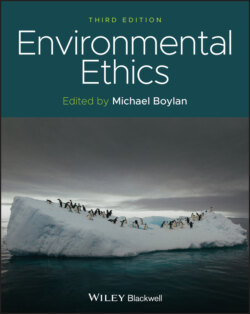Читать книгу Environmental Ethics - Группа авторов - Страница 12
Source Credits
ОглавлениеThe editor and publisher gratefully acknowledge the permission granted to reproduce the copyright material in this book:
Chapter 3
Garrett Hardin, “The Tragedy of the Commons,” Science, 13 December 1968: pp. 1243−1248. Reprinted with the permission of???
Chapter 4
Aldo Leopold, “The Land Ethic,” A Sand County Almanac: and Sketches Here and There, Oxford: Oxford University Press, 1949; pp. 41–48. Reprinted with the permission of Oxford University Press.
Arne Naess, “The Shallow and the Deep, Long-Range Ecology Movement,” Inquiry, 16 (1983): 95–100. Reprinted with the permission of Taylor & Francis Journals.
Carolyn Merchant, “Ecofeminism and Feminist Theory,” in Reweaving the World: The Emergence of Ecofeminism (eds Irene Diamond and Gloria Orenstein), Sierra Club Books, 1990; pp. 77–83. Reprinted with the permission of the author.
Karen J. Warren, “The Power and Promise of Ecological Feminism,” Environmental Ethics, 12 (1990): 125–126, 138–145. With kind permission from the author.
Janna Thompson, “Aesthetics and the Value of Nature,” Environmental Ethics, 17 (3) (1995): 291–306. Reprinted with permission.
Chapter 5
Onora O’Neill, “Environmental Values, Anthropocentrism and Speciesism,” Environmental Values, 6 (1997): 127–142. Reprinted with permission.
Holmes Rolston III, “Environmental Ethics: Values in and Duties to the Natural World,” from F. Herbert Bormann and Stephen R. Kellert (eds.), The Broken Circle: Ecology, Economics, and Ethics, Yale University Press, 1991; pp. 228–247. Reprinted with the permission of Yale University Press.
Paul Taylor, “Respect for Nature: A Theory of Environmental Ethics,” from Respect for Nature, Princeton University Press, 1986; pp. 248–259. c 1986 Princeton University Press. Reprinted with permission.
James P. Sterba, “Reconciling Anthropocentric and Nonanthropocentric Environmental Ethics,” Environmental Values, 3 (1994): 229–244. Reprinted with permission.
Brian K. Steverson, “On the Reconciliation of Anthropocentric and Nonanthropocentric Environmental Ethics,” Environmental Values, 5 (1996): 349–361. Reprinted with permission.
James P. Sterba, “Reconciliation Reaffirmed: A Reply to Steverson,” Environmental Values, 5 (1996): 363–368. Reprinted with permission.
Chapter 7
Peter Singer, “Animal Liberation,” New York Review of Books, April 5, 1973 c Peter Singer, 1973. Reprinted with the kind permission of the author.
Tom Regan, “The Radical Egalitarian Case for Animal Rights,” from In Defence of Animals (ed. Peter Singer), Blackwell, 1985; pp 320–330. Reprinted with the permission of John Wiley & Sons Ltd.
Mary Anne Warren, “A Critique of Regan’s Animal Rights Theory,” from Between Species, 2 (4) (1987): 331–333, see at: http://digitalcommons.calpoly.edu/bts. Reprinted with permission.
Dale Jamieson, “Against Zoos,” in In Defense of Animals: The Second Wave (ed. Peter Singer), Blackwell, 2005; pp. 132–143. Reprinted with the permission of John Wiley & Sons Ltd.
Chapter 8
Stephen Gardiner, “A Perfect Moral Storm: Climate Change, Intergenerational Ethics, and the Problem of Moral Corruption,” Environmental Values, 15 (3) (August 2006): 397–413. Reprinted with permission.
Wilfred Beckerman, “‘Sustainable Development’: Is it a Useful Concept?” Environmental Values, 3 (1994): 191–209. Reprinted with permission.
Herman E. Daly, “On Wilfred Beckerman’s Critique of Sustainable Development,” Environmental Values, 4 (1995): 49–55. Reprinted with permission.
Steve Vanderheiden PSQUAD TO SUPPLY
